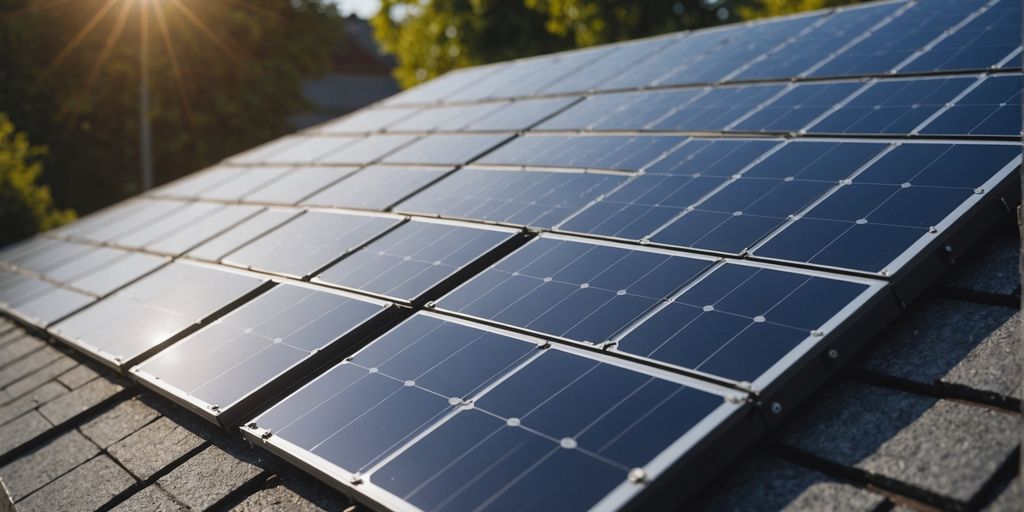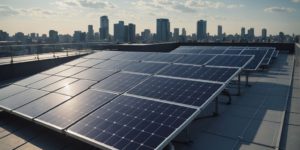Solar panel protective covers are essential accessories designed to shield solar panels from environmental damage, thereby ensuring their longevity and optimal performance. These covers come in various types and are made from different materials, each offering unique benefits. In this article, we will explore the different aspects of solar panel protective covers, including their types, materials, benefits, installation process, and maintenance tips. We will also delve into innovative technologies, DIY vs. professional installation, and future trends in solar panel protection.
Key Takeaways
- Solar panel protective covers help to extend the lifespan and efficiency of solar panels by protecting them from environmental damage such as dust, debris, and bird droppings.
- There are various types of protective covers available, including reflective covers, transparent plastic covers, and hardcovers for impact protection.
- Proper installation and regular maintenance of protective covers are crucial to ensure their effectiveness and the optimal performance of solar panels.
- Innovative technologies in protective covers, such as smart covers and advanced materials, are emerging to offer better protection and integration with solar panel systems.
- Choosing the right protective cover involves considering factors like the specific environmental threats, cost vs. benefit analysis, and the potential need for customization.
Understanding Solar Panel Protective Covers
Solar panel protective covers serve as essential barriers between your solar panels and the harsh elements of the environment. These covers, often crafted from robust materials, help maintain the efficiency of solar panels by keeping them clean and free from debris. They are easy to install and remove, and can be tailored to fit various solar panel models.
Types of Protective Covers
There are several types of solar panel protective covers available, each designed to address specific needs:
- Mesh Covers: Ideal for preventing small animals and birds from nesting under the panels.
- Hard Covers: Provide impact protection from hail and other debris.
- Transparent Covers: Allow sunlight to pass through while protecting the panels from dust and dirt.
Materials Used in Covers
The materials used in solar panel protective covers vary based on their intended function:
- Polycarbonate: Known for its durability and transparency, making it suitable for transparent covers.
- Metal Mesh: Often used in mesh covers to keep out critters and birds.
- Rubber and Silicone: Used in clips and seals to ensure a snug fit and prevent water ingress.
Benefits of Using Protective Covers
Using protective covers for your solar panels offers numerous benefits:
- Enhanced Longevity: Protects panels from physical damage and environmental wear and tear.
- Improved Efficiency: Keeps panels clean, ensuring maximum sunlight absorption.
- Cost Savings: Reduces the need for frequent maintenance and potential repairs.
Investing in a Solar Panel Protective Cover not only safeguards your panels but also ensures they operate at peak efficiency, providing you with reliable and sustainable energy for years to come.
How Solar Panel Protective Covers Work
Solar panel protective covers serve as a crucial barrier, shielding the panels from various environmental factors. These covers are designed to maintain the efficiency and longevity of solar panels by preventing damage from external elements such as dust, debris, and weather conditions. Understanding the mechanism of these covers can help in optimizing the performance of your solar power system.
Choosing the Right Protective Cover for Your Solar Panels
Selecting the appropriate protective cover for your solar panels is crucial for ensuring their longevity and efficiency. Here are some key considerations to help you make an informed decision.
Protecting Solar Panels from Environmental Damage
Solar panels are a significant investment, and protecting them from environmental damage is crucial to ensure their longevity and efficiency. Various factors such as weather, animals, and debris can pose threats to solar panels. Implementing protective measures can help mitigate these risks and maintain optimal performance.
Weather-Related Damage
Solar panels are exposed to various weather conditions, including rain, snow, hail, and extreme temperatures. Protective covers can shield panels from these elements, preventing potential damage. Additionally, some covers are designed to reduce heat absorption, enhancing the overall efficiency of the solar system.
Bird and Animal Protection
Birds and animals can cause significant damage to solar panels. Pigeon Guard For Solar Panels and other deterrents can prevent birds from nesting under the panels, which can lead to droppings and debris accumulation. Natural Bird Deterrents like fake predators or mesh can also be effective in keeping birds away. For more robust protection, consider installing Pigeon Spikes For Solar Panels to stop birds nesting under solar panels.
Dust and Debris Prevention
Dust and debris can accumulate on solar panels, reducing their efficiency. Regular cleaning and maintenance are essential to keep the panels functioning optimally. Installing protective covers can also help minimize the buildup of dust and debris, ensuring consistent energy production.
Tip: Regular inspections and maintenance can significantly extend the lifespan of your solar panels and ensure they operate at peak efficiency.
By taking these protective measures, you can safeguard your solar panels from environmental damage and ensure they continue to provide clean, renewable energy for years to come.
Innovative Protective Cover Technologies
Reflective Covers
Reflective covers are designed to deflect sunlight, reducing heat absorption and potentially increasing the efficiency and lifespan of solar panels. These covers are particularly beneficial in hot climates where excessive heat can degrade panel performance. Reflective materials used in these covers help maintain optimal temperatures, ensuring longevity and performance.
Transparent Plastic Covers
Transparent plastic covers allow light to pass through while protecting panels from dust, bird droppings, and debris. These covers are an excellent choice for maintaining the cleanliness and efficiency of solar panels. They act as a barrier against environmental elements, ensuring that the panels remain unobstructed and functional.
Hardcovers for Impact Protection
Hardcovers provide robust protection against physical impacts, such as hail or falling branches. These covers are essential for areas prone to severe weather conditions. By shielding the panels from direct hits, hardcovers help prevent damage and maintain the integrity of the solar panel system.
Investing in innovative protective covers can significantly enhance the resilience and efficiency of your solar panels, ensuring they remain in optimal condition for years to come.
DIY vs. Professional Installation of Protective Covers
Pros and Cons of DIY
Opting for a DIY installation of solar panel protective covers can be cost-effective and give you a sense of accomplishment. However, extreme caution is required to avoid damaging the panels or voiding the warranty. DIY installations might not be as secure as professional ones, potentially leading to issues like improper fitting or reduced efficiency.
When to Hire a Professional
Hiring a professional ensures that the installation is done correctly and safely. Professionals have the expertise to handle complex installations and can provide tailored solar solutions for homes and businesses. This is particularly important for large or intricate systems where mistakes can be costly.
Safety Considerations
Safety should be a top priority whether you choose DIY or professional installation. Professionals are trained to handle installations safely, reducing the risk of accidents. For DIY enthusiasts, it’s crucial to follow all safety guidelines and use appropriate equipment to prevent injuries or damage to the panels.
Case Studies: Effective Use of Solar Panel Protective Covers
In residential settings, solar panel protective covers have proven to be highly effective. Homeowners have reported a significant reduction in maintenance costs and an increase in the efficiency of their solar panels. For instance, a family in Arizona installed a solar panel system skirt for $500. This not only added style to their solar system but also provided a sleek barrier against dust and debris.
Commercial entities have also benefited from the use of protective covers. A shopping mall in California saw a 15% increase in energy production after installing custom-fitted covers. These covers protected the panels from bird droppings and other environmental factors, ensuring optimal performance.
In industrial applications, the use of protective covers has been instrumental in maintaining the longevity and efficiency of large-scale solar installations. A manufacturing plant in Texas reported that their solar panels remained clean and functional even during severe weather conditions, thanks to the durable protective covers they installed.
Protective covers are a cost-effective solution for maintaining the efficiency and longevity of solar panels across various applications.
Common Mistakes to Avoid with Solar Panel Protective Covers
Improper Installation
One of the most frequent errors is improper installation of solar panel protective covers. This can lead to inadequate protection and even damage to the panels. It’s crucial to follow the manufacturer’s guidelines meticulously and, if in doubt, consult a professional to ensure the covers are installed correctly.
Neglecting Maintenance
Regular maintenance is essential for the longevity and efficiency of your solar panel protective covers. Neglecting maintenance can result in the buildup of dirt and debris, which can reduce the effectiveness of the covers. Prioritize safety and schedule routine inspections and cleanings to keep your covers in optimal condition.
Choosing the Wrong Material
Selecting the wrong material for your solar panel protective covers can significantly impact their performance. Different environments require different materials, so it’s important to choose a cover that is suited to your specific needs. For instance, hardcovers may be necessary in areas prone to hail, while transparent plastic covers might be better for regions with less severe weather conditions.
Ensuring that you choose the right material and maintain your covers properly can save you from costly repairs and replacements in the long run.
Future Trends in Solar Panel Protection
Advancements in Materials
The future of solar panel protection is set to be revolutionized by constant improvement in solar panel technology. New materials are being developed that offer enhanced durability and efficiency. These materials not only protect the panels from environmental damage but also improve their overall performance. For instance, self-healing materials that can repair minor damages on their own are being researched and could soon become a standard feature in solar panel protective covers.
Smart Protective Covers
Smart technology is making its way into solar panel protection. These covers can adjust their properties based on the weather conditions, providing optimal protection at all times. For example, they can become more reflective during intense heat waves to prevent overheating or more transparent during cloudy days to maximize energy absorption. This adaptability ensures that the panels are always operating at their best, regardless of the external conditions.
Integration with Solar Panel Systems
Future protective covers will not just be an add-on but an integral part of the solar panel systems. They will be designed to work seamlessly with the panels, enhancing their efficiency and longevity. This integration will also make the installation process simpler and more cost-effective. Governments are likely to offer incentives for adopting these advanced protective covers, further driving their widespread adoption.
The future of solar panel protection is bright, with innovations that promise to make solar energy more reliable and efficient than ever before.
Regulations and Standards for Solar Panel Protective Covers
Industry Standards
Solar panel protective covers must adhere to specific industry standards to ensure optimal performance and safety. These standards often include guidelines on material durability, UV resistance, and impact protection. Compliance with these standards ensures that the covers can withstand various environmental conditions and provide long-term protection for solar panels.
Compliance Requirements
Manufacturers and installers must comply with local and international regulations when producing and installing solar panel protective covers. This includes meeting safety standards, environmental regulations, and quality assurance protocols. Compliance ensures that the covers do not negatively impact the performance of the solar panels and that they provide adequate protection against environmental damage.
Environmental Impact
The production and disposal of solar panel protective covers can have an environmental impact. It is essential to choose covers made from sustainable materials and to follow proper disposal methods to minimize this impact. Additionally, some regulations may require manufacturers to provide information on the environmental footprint of their products.
Ensuring that your solar panel protective covers meet all relevant regulations and standards is crucial for maintaining the efficiency and longevity of your solar panel system.
Customer Reviews and Testimonials

Positive Experiences
Many customers have shared their satisfaction with solar panel protective covers. One customer noted a significant reduction in maintenance costs after installing the covers. Another mentioned that the covers provided excellent protection against environmental damage, ensuring the longevity of their solar panels.
Challenges Faced
While most feedback is positive, some users have faced challenges. A few customers reported difficulties during the installation process, particularly with custom-fit covers. Additionally, some found that the covers required more frequent cleaning than anticipated to maintain optimal performance.
Lessons Learned
From the reviews, it’s clear that proper installation and regular maintenance are crucial for the effectiveness of solar panel protective covers. Customers recommend consulting with professionals for installation to avoid common pitfalls. Regular cleaning and inspections can also help in maximizing the benefits of the covers.
Investing in high-quality protective covers can save you from costly repairs and replacements in the long run. Simplifying solar solutions with the right products can make a significant difference in the performance and durability of your solar panels.
Our customers love the benefits of switching to solar energy, and their testimonials speak volumes about our commitment to quality and service. Don’t just take our word for it, see what they have to say and explore our range of solar products and services. Visit our website to learn more and start your journey towards a sustainable future today!
Conclusion
In conclusion, the use of solar panel protective covers is an essential measure to ensure the longevity and efficiency of solar energy systems. These covers provide a robust barrier against environmental elements such as dust, bird droppings, and debris, which can significantly impact the performance of solar panels. By investing in high-quality protective covers, solar panel owners can safeguard their investment, reduce maintenance costs, and enhance the overall productivity of their solar installations. As the demand for renewable energy continues to grow, incorporating protective measures like these will be crucial in maximizing the benefits of solar technology.
Frequently Asked Questions
What are solar panel protective covers?
Solar panel protective covers are barriers made from durable materials designed to shield solar panels from environmental conditions such as dust, rain, bird droppings, and debris. They help maintain the efficiency and longevity of the panels.
What materials are used in solar panel protective covers?
Common materials used in solar panel protective covers include UV-resistant polypropylene, transparent plastics, and reflective materials. These materials are chosen for their durability and ability to protect without obstructing sunlight.
How do solar panel protective covers work?
Solar panel protective covers work by creating a physical barrier that prevents harmful elements like dirt, debris, and bird droppings from reaching the solar panels. Some covers are designed to be transparent or reflective to allow sunlight to pass through or to deflect excess heat.
What are the benefits of using solar panel protective covers?
The benefits of using solar panel protective covers include increased efficiency, prolonged lifespan of the panels, reduced maintenance costs, and protection from environmental damage such as hail, bird droppings, and dust.
Can I install solar panel protective covers myself?
Yes, many solar panel protective covers are designed for easy DIY installation. However, for more complex systems or to ensure optimal installation, it may be beneficial to hire a professional.
How often should I maintain or clean the protective covers?
It is recommended to inspect and clean the protective covers at least once a year. Regular maintenance ensures that the covers remain effective and do not obstruct sunlight from reaching the panels.
Are there different types of solar panel protective covers?
Yes, there are various types of protective covers, including transparent plastic covers, reflective covers, and hardcovers for impact protection. Each type offers different benefits depending on the specific environmental challenges faced.
How much do solar panel protective covers cost?
The cost of solar panel protective covers varies depending on the material, size, and type of cover. It is important to conduct a cost vs. benefit analysis to determine the most economical option for your needs.



